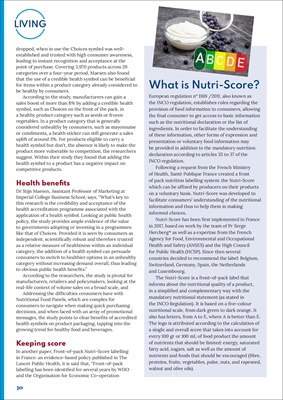
30
LIVING
dropped, when in use the Choices symbol was wellestablished
and trusted with high consumer awareness,
leading to instant recognition and acceptance at the
point of purchase. Covering 3,970 products across 29
categories over a four-year period, Maesen also found
that the use of a credible health symbol can be beneficial
for items within a product category already considered to
be healthy by consumers.
According to the study, manufacturers can gain a
sales boost of more than 8% by adding a credible health
symbol, such as Choices on the front of the pack, in
a healthy product category such as seeds or frozen
vegetables. In a product category that is generally
considered unhealthy by consumers, such as mayonnaise
or condiments, a health sticker can still generate a sales
uplift of around 3%. For products eligible to carry a
health symbol but don't, the absence is likely to make the
product more vulnerable to competition, the researchers
suggest. Within their study they found that adding the
health symbol to a product has a negative impact on
competitive products.
Health benefits
Dr Stijn Maesen, Assistant Professor of Marketing at
Imperial College Business School, says, "What's key to
this research is the credibility and acceptance of the
health accreditation programme associated with the
application of a health symbol. Looking at public health
policy, the study provides ample evidence of the value
to governments adopting or investing in a programmes
like that of Choices. Provided it is seen by consumers as
independent, scientifically robust and therefore trusted
as a relative measure of healthiness within an individual
category, the addition of a health symbol can persuade
consumers to switch to healthier options in an unhealthy
category without increasing demand overall, thus leading
to obvious public health benefits."
According to the researchers, the study is pivotal for
manufacturers, retailers and policymakers, looking at the
real-life context of volume sales on a broad scale, and
Addressing the difficulties consumers have with
Nutritional Food Panels, which are complex for
consumers to navigate when making quick purchasing
decisions, and when faced with an array of promotional
messages, the study points to clear benefits of accredited
health symbols on product packaging, tapping into the
growing trend for healthy food and beverages.
Keeping score
In another paper, Front-of-pack Nutri-Score labelling
in France: an evidence-based policy published in The
Lancet Public Health, it is said that, "Front-of-pack
labelling has been identified for several years by WHO
and the Organisation for Economic Co-operation
What is Nutri-Score?
European regulation n° 1169 /2011, also known as
the INCO regulation, establishes rules regarding the
provision of food information to consumers, allowing
the final consumer to get access to basic information
such as the nutritional declaration or the list of
ingredients. In order to facilitate the understanding
of these information, other forms of expression and
presentation or voluntary food information may
be provided in addition to the mandatory nutrition
declaration according to articles 35 to 37 of the
INCO regulation.
Following a request from the French Ministry
of Health, Santé Publique France created a front
of pack nutrition labelling system: the Nutri-Score
which can be affixed by producers on their products
on a voluntary basis. Nutri-Score was developed to
facilitate consumers' understanding of the nutritional
information and thus to help them in making
informed choices.
Nutri-Score has been first implemented in France
in 2017, based on work by the team of Pr Serge
Hercberg* as well as a expertise from the French
Agency for Food, Environmental and Occupational
Health and Safety (ANSES) and the High Council
for Public Health (HCSP). Since then several
countries decided to recommend the label: Belgium,
Switzerland, Germany, Spain, the Netherlands
and Luxembourg.
The Nutri-Score is a front-of-pack label that
informs about the nutritional quality of a product,
in a simplified and complementary way with the
mandatory nutritional statement (as stated in
the INCO Regulation). It is based on a five-colour
nutritional scale, from dark green to dark orange. It
also has letters, from A to E, where A is better than E.
The logo is attributed according to the calculation of
a single and overall score that takes into account for
every 100 gr or 100 mL of food product the amount
of nutrients that should be limited: energy, saturated
fatty acid, sugars, salt as well as the amount of
nutrients and foods that should be encouraged (fibre,
proteins, fruits, vegetables, pulse, nuts, and rapeseed,
walnut and olive oils).